 TRIZ
Textbooks: CID Course for Children, 1-1G3 TRIZ
Textbooks: CID Course for Children, 1-1G3 |
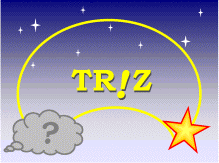  
|
Topic 3:
How feels this or that? How seems this or that?
(Properties of the systems) |
Fairy Tales
School:
Course of Creative Imagination
Development (CID), 1st Grade, 1st Semester, Methodical Guide-Book |
Natalia
V. Rubina, 1999 [published
in Russian]
English
translation by Irina Dolina,
May 23, 2000
Technical
Editing by Toru Nakagawa,
Feb. 28, 2001 |
Posted
in this "TRIZ Home Page in Japan" in English on Feb. 28, 2001 under the
permission of the Author.
(C) N.V. Rubina,
I. Dolina, and T. Nakagawa 2001 |
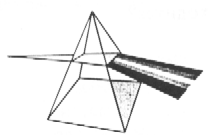 |
Topic 3:
How feels this or that? How seems this or that?
(Properties of the systems) |
Workbook
Lesson 1.
1. Warming up (Card-index
for the first grade)
2. Homework check up
3. Introduction to the lesson

"Yes-No game".
Deli-Davai gave a riddle
to Emil: there is a small object in a black box. What is it?
(Emil asked the Sorcerer
only three questions)
4. Main topic
| Properties are
the characteristics of the system that may be changed. By the
properties it is possible to tell one system from the other. For
example, all the systems have a common property: they can split into
parts. |
Recognize it by description:

white, rectangular,
small, leaves a trace: ___________________________
white, thin, crumpling:
_____________________________
round, pattern,
jingle and crash: ________________________
rectungular,soft, erase
traces of a pencil: _______________________
long, shiny, sharp, solid:
______________________
Each description suggests a few types of the systems in mind. It is important
that a kid explains why he offers this system in particular.
To solve all the riddles
of the Sorcerer Deli-Davai you should remember about the changing
properties of the systems (Card-index for the first form).
5. Psychotechnical and developing games
The game we are going
to play now is called "Who does it or he resemble?"
Each of you has a picture
on the table with an animal. But I have picture with no animal on
it, no bird, no fish and no insect.
On my picture there is
a cloud, its name is Colabo. It has come to visit us specially for
our game.
Thus Colabo will play
only with somebody or something that looks like him. For example,
what does a dog and Colabo have in common?
- It is as
fluffy as a cloud.
- How about a rabbit?
- It is as white
as a rabbit.
- And what does
a rabbit have in common with a lion?
- They both have
round eyes.
- And who else
has round eyes?
- Actually all
do. Let's split into groups. Raise the card those who are hedgy.
Raise the cards those who are hairy. (We discover that every animal
has as a matter of fact nearly any property).
You choose
the way to conduct a game taking consideration specific features of the
class (individually, all together, in groups).
Another way.
You show the students simultaneously 3-4 cards depicting any systems and
ask them to find an object that doesn't belong there. As a rule,
it is possible to prove that any object might be crossed out. It
is important that the kids should point out the properties that makes
this particular system different from all the others.
6. Activities on speech skills developing
or producing the creative product


Today I have brought
for you very many maple leaves.
(The groups consisting
3-4 people get a heap of maple leaves.) Let's look at those leaves
very attentively and try to find two identical leaves and two absolutely
identical pattern drawings.
Well, what have we got?
(We try to find the most subtle differences in the very similar maple leaves).
Let's sum up: there are
no two absolutely identical objects; everything is unique. And
any of you has your own world view and opinion about everything in the
world.
Then, show me two leaves
that are absolutely different.
(We find the most subtle
features of resemblance of all the leaves.)
- All of them are
alike; all of them are from a maple tree.
- Well, of course.
It is impossible to find two objects in the world that have absolutely
nothing in common.
This activity may be performed
at home with the parents.
Knowing which properties our object have
and what it resembles, we may devise many riddles about it.
| What kind of? |
What does it resemble? |
| . |
. |
|
| What kind of? |
What is the difference? |
| . |
. |
|
| What kind of? |
What is the same ? |
| . |
. |
|
Of course,
to work with three tables at once is difficult for the kids. It's
easier to use them one after one on different levels, thus repeating
the topic of properties.
7. While summing up,
Do not ask
the kids to give exact definitions to the properties. What is more
important is that they should learn to find as many different properties
of different systems as possible.
Workbook
Lesson 2.
1. Warming-up. (The Card-index
for the first grade)
2. Homework check-up.
The students who name
the properties of the system under consideration may seat down.
3. Introduction to the lesson.
What properties may
be found?
4. The main topic.
The system has plenty
of properties. Let's consider in detail some of them:
Shape

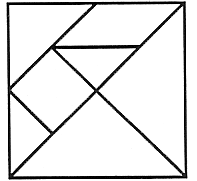
There is a riddle devised
by Pythagoras before you.
Name the shapes that
you can see. Cut them neatly.
And now fold the square.
Color

It was very quiet in
the house. Emil, tired from games and lessons, decided to go to bed
earlier about 6 o'clock, and in order not to oversleep he set the
alarm at 7 a.m. as usual.
The night passed.
The alarm clock rang. Emil woke up, got dressed.
"How long have I been
sleeping?"- he thought.
And what do you think?...................................
Emil woke up very early
and saw a wonderful thing out of the window: color bow over the river.
What is it?
- Rainbow!
What does the rainbow
consist of?
| Each
- |
. |
| Hunter - |
. |
| Wish
- |
. |
| To know - |
. |
| Where - |
. |
| Sits
- |
. |
| Pheasant - |
. |
Draw a rainbow.
[Translation Note:
The Russian words for the above phrase "Each Hunter Wish to Know Where
Sits Pheasant" start with letters common with the words of the seven colors.]
6. Activities on speech skills developing
and producing the creative product

In this table there are
four properties by which you can identify any object. Look:
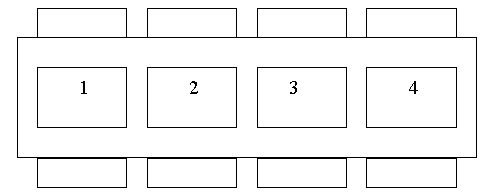
1 - size; 2 - color; 3 - shape;
4 - temperature.
In order to show what kind
of object it is, we will designate the size, color, form and temperature.
Now by moving the scale
we can show which properties this mysterious object possesses. For example"
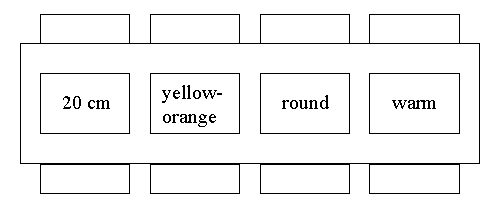
- Is it a bread?
- No.
- Is it a toy?
- No
- Is it animated?
- Yes.
- Is it a chicken?
- No.
- Is it a kitten?
- Yes. Good for you!
7. Summing up
Find
out whether the kids learned to use their knowledge about various system
properties for solving problems.
Last updated
on Feb. 28, 2001. Access point: Editor: nakagawa@utc.osaka-gu.ac.jp






